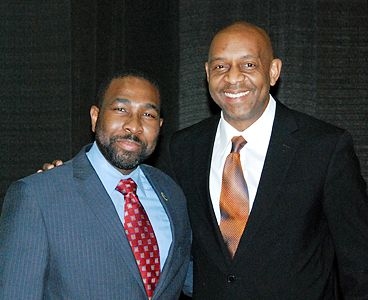Some students may aspire to earn a PhD, while others may plan to become physicians. In either case, Robert Satcher Jr. ’86, PhD ’93 provides a soft-spoken, engaging example. But he is also equally interesting to that rare student who dreams of becoming an astronaut.
Satcher, an orthopedic oncologist who flew on a 2009 NASA space shuttle mission during which he made two spacewalks, spoke to students on Friday, Feb. 18, at the annual induction ceremony for new student members of the Laureates and Leaders program. The program is designed to encourage motivated and talented students from underrepresented minorities to pursue advanced academic degrees.
At a small, informal reception for students before the ceremony, Satcher described how he “always wanted to be a doctor” and that “the astronaut thing … kind of came about serendipitously.” Even now, as a full-time astronaut, he still practices medicine part-time, he said.
Satcher described growing up in a small town of about 3,000 people in South Carolina that “had not had anybody go to MIT” before him, and added that he went through “culture shock when I got here.” After a shaky first year, he said, “I found my groove” in his second year as a chemical engineering major.
In his keynote address during the Laureates and Leaders ceremony, at which 20 MIT sophomores were inducted into the program, Satcher pointed out that as an undergraduate, he had only one African-American professor during his whole time here from 1982-86. To the assembled laureates he said, “you all are part of the solution in terms of changing that.”
Now in its third year, the Laureates and Leaders program selects students based on their academic performance and motivation toward advanced studies, and those selected are provided with mentoring, networking, workshops and financial assistance for research.
One of the new inductees, Camille Everhart, said that "What is really amazing about the program is the network of people helping us to understand the inner workings of the road to a doctorate. Financial support alone cannot give you that." As a fan of NASA, she was delighted to hear Satcher, who she said "is truly an inspiration, raising the bar for us all, in the minority community and beyond."

The 2011 inductees of MIT's Laureates and Leaders program
Photo: Eddie Porter
Satcher also talked about the many African-American astronauts through the years, including the first one selected, Robert Lawrence in 1967, who died during a training accident and was long neglected in histories of the space program because he had not actually flown a mission. He also recalled that as an MIT undergraduate, he had a chance to meet Ronald McNair PhD ’76, one of the astronauts who later died in the Challenger shuttle disaster in 1986.
Satcher spoke enthusiastically about the joys of being in the space program, showing pictures from his shuttle mission in 2009 — including one of him during a spacewalk with a big smile on his face.
In addition to images of the space program, Satcher interspersed his talk with pictures of his numerous trips to developing countries in West Africa, where he went to provide medical services. One of the thoughts that struck him during those visits to resource-poor nations where “they don’t have a lot of the stuff we take for granted here," is that “you could have the next Einstein there, or the next Watson and Crick there, and you’d never know, because they just didn’t have the opportunity to participate in the activities that would bring that out.”
So to accomplish the goals we set as a nation, including the mission of exploration that NASA is pursuing, “it requires that we take advantage of the opportunities that we’ve got here,” and also that “we make resources available to people … We need to get everybody on board, we need to take advantage of all the talents out there.”
Dedric Carter ’98, who just last month left MIT to become senior advisor for strategic initiatives at the National Science Foundation, gave the other keynote talk at Friday’s ceremony. He spoke of “the challenge for all of us, as a nation — how do we bring the best talent to the greatest problems?” He urged the students to find the areas they care most about, and follow those dreams. “I’m not defining what ‘it’ is,” he said, but “you have to want it passionately, and once you want it, make it so.”






